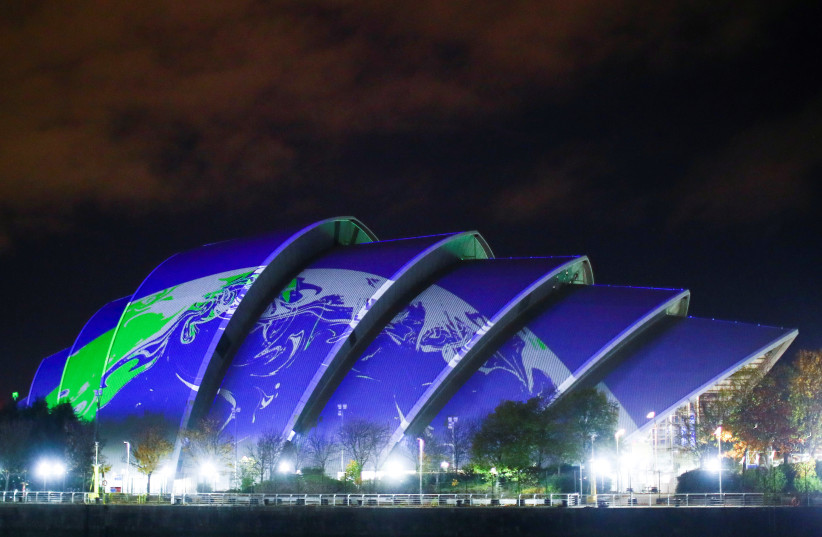GLASGOW – The line to get into the United Nations Climate Conference started long before the “Armadillo,” the Scottish Event Campus’s nickname due to its resemblance to the animal’s shell, came into view.
With the usual security and credential checks at any conference, plus having to show that we registered negative COVID-19 rapid test results on the UK National Health Service website, tens of thousands of attendees created a bottleneck outside. They queued, as the locals would say, in weather that Israelis would consider quite wintry, with frigid wind blowing off of the River Clyde.
Luckily, there was a kilt-wearing man standing on a soapbox, with a speaker playing the “Imperial March (Darth Vader’s Theme),” to entertain us.
“We’re so proud to host our international imperial masters,” the man shouted with a Scottish lilt into a squeaky microphone. “All the finance we invested in this. What a useful way to spend the taxpayers’ money!”
The nearly an hour and a half wait gave us plenty of time to consider how much the conference, meant to save the environment, was actually polluting it, with a reported 400 private jets used to attend.

The Israeli delegation had its own plane, as well, and stayed in Edinburgh, taking non-electric buses for over an hour to get to the conference.
Eventually, the Israeli press delegation entered the conference center, ready to mingle and explore.
Once inside, with coats off, the throng that had lined up to get in could be seen and heard in all of its diverse, international glory.
It seemed like every language in the world was being spoken at COP26, as the climate conference is called.
Though most attendees were in Western business attire, there were many examples of traditional dress from around the world. There were members of indigenous South American tribes in woven shirts, Saudi men in keffiyehs, Korean women in pastel robes, African men and women wearing colorful prints and Indonesian women in feathered headdresses.
Countries, international groups – like the EU, African Union – and others; organizations – like the World Wildlife Foundation – climate initiatives and others, set up large booths.
Countries like Turkey, Morocco, Thailand and others designed their pavilions to reflect their local architecture styles. A Pan-African area featured a straw hut; inside a man in a suit sat typing away on his laptop.
Some of the pavilions had schedules of events, with panel discussions featuring climate and environmental experts from their countries, but passers-by couldn’t hear them; anyone wanting to listen to a panel had to use a headset so that the discussions wouldn’t add to the cacophony in the conference hall.
SOME COUNTRIES didn’t quite seem to get the memo on what the conference is about and were promoting tourism.
Qatar was one of them, with models of the various soccer stadiums to be used in next year’s World Cup taking up a large chunk of their pavilion.
They also had a little black booth for “Doha Debates,” where conference-goers can participate in discussions with people who showed up via video link on a big screen.
At one point, two women from Gaza, Farah and Saly, participated.
Curious about what climate activism – or any activism, really – looks like, under Hamas rule, I asked what they are trying to do for the environment and to mitigate climate change.
“We have some activities, but we are limited because we don’t have funding and, you know, the occupation situation,” one said. When pressed further, they repeated that the environment is a low priority, because they have bigger problems.
Setting aside the absurdity that Israel is the big environmental problem, when untreated sewage from Gaza is dumped into the Mediterranean, among other ills; the women’s response highlights a big problem with the conference and its aims.
It’s challenging to get the developing world to care about clean energy when they don’t even have enough energy of any kind to provide electricity for all of their residents.
But even the poor countries with pavilions tried to put a positive spin on the proceedings, focusing on efforts to conserve the beautiful nature or save endangered species in their countries.
When the world leaders’ speeches began, only VIPs had access to the hall, so much of the mingling at the booths went on like nothing else was happening.
Journalists gathered in a press room with room for hundreds to write or broadcast. Several gathered around a television screen where US President Joe Biden and French President Emmanuel Macron’s addresses were aired. No one stood by the TV for Prime Minister Naftali Bennett’s speech; the Israeli press delegation was given the text in advance and watched on their own electronic devices.
The day ended with the news that wheelchair-bound Energy Minister Karin Elharrar couldn’t even get into the conference.
Climate was the cause du jour, and it seemed like the organizers couldn’t be bothered to make their event accessible for people with different needs. That put a damper on how the festivities were viewed by many in the Israeli delegation.
